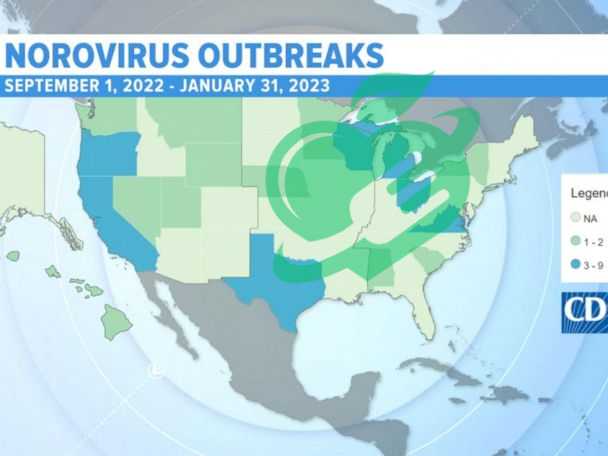A Look Ahead: The Evolving Landscape of Norovirus in 2025

A Look at Norovirus in 2025
As we move into 2025, norovirus is still a big player in the world of infectious diseases. This highly infectious virus causes a lot of trouble, especially in places like schools cruise ships and hospitals. To really get what’s going on with norovirus in 2025 we gotta recognize how it sticks around and changes as well as how research and public health responses have improved.
Current Stats and Effects
In 2025, norovirus is still one of the top causes of gastroenteritis across the globe. Here are some recent stats:
- Infection rates: Around 20 million cases of norovirus happen each year just in the United States.
- Hospitalizations: More than 70,000 people are hospitalized every year due to dehydration and other serious issues caused by the virus.
- Economic costs: Managing norovirus outbreaks costs about $2 billion each year, mainly from healthcare costs and lost productivity.
These numbers show how important it is to keep working hard against this virus and to stop outbreaks.
How Norovirus Spreads
Norovirus is tough partly because of how it spreads, which includes:
- Fecal-oral route: This is the main way it spreads. It shows why good hygiene and sanitation are super important.
- Contaminated food and water: Many outbreaks happen because of bad shellfish or fruits, highlighting why food safety matters.
- Surface contamination: This virus can live on surfaces for a while, making thorough cleaning necessary, especially in public places.
The virus’s skill at mutating means it can change every season, affecting how many people get sick.
Read also: Uncovering the Truth: The Reality of Leprosy in Florida.
The Need for Public Awareness
Raising awareness about norovirus is super important in 2025. Public campaigns focus on:
- Handwashing: Regular and thorough handwashing is still the best defense.
- Staying informed: Knowing symptoms like nausea, vomiting, and diarrhea can help with early detection.
- Effective reporting: Communities are urged to quickly report outbreaks to local health authorities to help stop the spread.
As we dive deeper into the challenges with norovirus, it’s clear that even though we’ve made big strides, staying alert and educating the public is key to limiting its impact on health. The next parts will check out new trends in research that help us understand and control this tough virus.
Read also: The Rising Threat of MPOX Cases: What You Need to Know.
New Research Trends in Norovirus 2025
With a solid grip on norovirus in 2025, researchers are paving the way for new strategies to tackle this virus. As scientists dig deeper, exciting breakthroughs are changing how we prevent and treat norovirus.
Progress in Vaccine Development
One exciting area is vaccine development. Historically, making vaccines for norovirus has been tough because it mutates so quickly. However, 2025 shows some promising developments:
- New vaccine candidates: Several candidates are in clinical trials using cutting-edge tech like mRNA to get a strong immune response.
- Focus on safety and efficacy: Researchers are looking at how long immunity lasts with these vaccines, especially against new strains.
For instance, a recent study from a big biomedical institute showed promising results with a new vaccine formulation giving immunity to 90% of participants.
Exploring Genetic Studies and Insights
Another big trend is looking at the molecular mechanisms of norovirus. This research focuses on:
- Identifying genetic markers: Understanding genetic differences can help explain varying susceptibility among people.
- Understanding virus-host interactions: By studying how the virus works with host cells scientists want to find possible treatment targets.
Some researchers share that this knowledge can lead to antiviral meds aimed specifically at how norovirus replicates.
Tech Innovations in Tracking Norovirus 2025
With tech on the rise, new methods are coming out to keep track of norovirus outbreaks more effectively:
- Real-time data collection: Using mobile apps and digital platforms helps health officials track outbreaks better and respond to health threats quicker.
- Surveillance of the environment: Researchers are checking viral counts in wastewater to predict outbreaks before they start, which is showing promise in urban areas.
Moving towards these fresh research trends shows how important team effort is across fields, from virology to public health. The next part will look into how norovirus affects public health, stressing why we need to tackle this virus for the sake of communities everywhere.
Read also: Shaping Tomorrow: Building a Better Future Post-COVID in 2025

How Norovirus 2025 Affects Public Health
Now that we’ve talked about new research on norovirus it’s important to consider its big impact on public health. Even with progress in understanding and fighting this virus, norovirus still challenges health systems globally sickening millions every year.
Widespread Outbreaks and Effects
Outbreaks of norovirus often happen in crowded spaces, leading to quick spread and serious health risks. Some main outcomes include:
- High infection rates: Norovirus causes over 90% of epidemic gastroenteritis cases around the world, hitting everyone from little kids to people older than 70.
- Hospitalizations: Serious dehydration can lead to hospitalization, especially for at-risk folks. Hospitals see spikes in admissions when outbreaks hit, putting a strain on healthcare resources.
- Economic impact: Handling norovirus outbreaks can be super costly. Estimates suggest the economic burden may go over $2 billion each year in the U.S. alone because of:
- Medical expenses
- Lost wages from missed work
- Costs related to public health responses
Thinking back on a personal story, a community health worker mentioned a big outbreak at a nearby school that caused an emergency response, showing the health effects and how it impacted families and the community too.
Vulnerable Groups Facing the Risks
Though norovirus can hit anyone hard, some folks are at more risk:
- Young children: Their growing immune systems make them more likely to feel severe symptoms.
- people older than 70: Older adults, especially those in care homes, are at a higher risk due to common health issues.
- People with weakened immune systems: Those dealing with chronic conditions or treatments might have worse outcomes.
Public health groups play an important role in protecting these individuals by using focused intervention strategies and regularly checking how well outbreak management works.
As we consider how norovirus impacts public health, it becomes clear that having effective preventative and control measures is important. Understanding these effects will highlight how we need global surveillance and prevention efforts, which we’ll discuss next.
Read also: The Health Benefits of Red Onion You Should Know.

Global Surveillance and Prevention Strategies
Now that we’ve looked into how norovirus affects public health it’s clear that having solid global surveillance and prevention actions is key to reducing this infectious threat. As health authorities and organizations ramp up their efforts, those actions are becoming more advanced and comprehensive.
Strengthening Global Surveillance
In recent times, countries have realized the importance of strong surveillance systems to spot and deal with norovirus outbreaks effectively. Key factors include:
- Collaboration across countries: Many nations now share data about norovirus cases, helping to spot new strains and trends faster.
- Real-time reporting: Health departments are using new tech that allows for quick reporting of cases so they can act fast. For example, mobile platforms collect and share outbreak details to stakeholders almost instantly.
An interesting story comes from a recent international conference where public health officials shared how real-time data helped contain outbreaks quickly before they turned serious. Participants were amazed by the lessons learned from countries with advanced tracking systems.
Preventive Actions and Public Awareness
Preventing norovirus infections relies on solid public health strategies. Some creative prevention actions include:
- Educational Initiatives: Campaigns promoting hand hygiene and safe food handling are crucial. School programs often teach kids why washing hands after using the restroom and before eating is important.
- Community Engagement: Working with local leaders and health workers helps create a sense of ownership for prevention actions. For example, one community health worker put together a “Hand Hygiene Day,” which got families involved.
While educational efforts are important, cleaning practices also matter. Regularly cleaning high-touch surfaces in public areas has worked well in slowing down the spread.
The Future of Global Cooperation
Looking forward to working together globally is key to ongoing success. Better cooperation between governments, NGOs, and health organizations will help share resources, knowledge, and strategies effectively.
As countries strengthen their tracking and prevention efforts the focus on collaboration will be super important in reducing the burden of norovirus. Next we’ll look into what the future holds for norovirus control to see what advancements lie ahead and what challenges we might face in this ongoing fight.
Read also: E. Coli Outbreak Update: Carrot Products Recalled
What’s Next for Norovirus 2025 Control
As we step away from looking at global tracking and prevention efforts, it’s time to chat about what’s next for controlling norovirus. Even with ongoing issues related to this tough virus, progress in research and fresh strategies hint at better ways to manage and prevent it.
New Technologies in Diagnostics and Treatment
One area ready for growth is improving how we diagnose norovirus. Fast and accurate testing is key for quick identification and action during outbreaks. Here’s what we expect to see:
- Point-of-care testing: Research is in the works for small, easy-to-use tests that can deliver results quickly even outside clinics.
- Biomarkers for severity prediction: Being able to tell which patients might get worse can really help enhance treatment plans.
Some health providers shared stories about how rapid tests were used more during a recent outbreak. They pointed out that these tests allowed clinicians to make quicker decisions, saving lives and helping stop the spread.
Innovative Vaccines and Antiviral Approaches
As we mentioned before, developing vaccines is essential. If successful, these vaccines could seriously shift the control landscape:
- Broad-spectrum vaccines: Researchers want to make vaccines that work against different norovirus strains, tackling the virus’s constant changes.
- Antiviral treatments: Scientists are looking into antiviral agents that could target norovirus replication in people which might lessen symptoms and illness duration.
This approach could give healthcare workers more ways to manage outbreaks effectively.
Frequently Asked Questions
Will there ever be a cure for norovirus 2025?
At present, there is no vaccine available for norovirus due to the numerous strains it encompasses and the difficult-to-predict nature of its evolution. The most promising norovirus vaccine is currently being tested by Moderna, with the trial expected to conclude in 2027. However, it may be several years after the trial’s completion before the vaccine receives public approval. 1.
When is the season for norovirus2025?
Norovirus is most prevalent from November to April, although it can actually happen at any time throughout the year. 2.
Why is norovirus so bad?
Norovirus is very contagious
The virus can persist on objects and surfaces for several days or even weeks, making it easy to spread in crowded places like nursing homes, daycare facilities, and cruise ships.2.
What kills norovirus?
Which cleaning products should I use to avoid norovirus? Barron suggests frequently cleaning surfaces with bleach-based cleaners, as they are effective in eliminating norovirus. 3.
Can you build immunity to norovirus?
Protection can be built against certain types; however, the duration of this protection is uncertain. This uncertainty might clarify why individuals of all ages experience infections during norovirus outbreaks. 4.
Community-Based Actions and Teamwork
The future of norovirus control also relies on getting communities involved. Local health initiatives can help empower people to take charge of their health:
- Promoting hygiene practices: Educational campaigns that connect with local customs will likely resonate more.
- Partnering with local organizations: Teaming up with schools, businesses, and non-profits can create a united response to outbreaks, leveraging resources wisely.
Thinking about a collaboration between a local school district and health department during a norovirus outbreak the fast actions taken to educate families played a huge part in managing the situation.
To stay up to date on the latest health and nutrition developments in the United States, visit our website, Power Up Your Health, and gain more tips and solutions for a healthier life.



